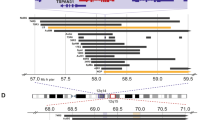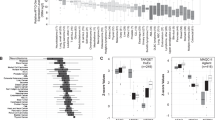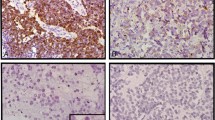Abstract
The MYCN proto-oncogene is frequently amplified in a subgroup of highly aggressive neuroblastomas. The molecular mechanism(s) by which the overexpressed MYCN contributes to an aggressive tumor cell behavior is not well understood. Recently, it was reported that the ID2 gene is a direct target for the MYCN and MYC transcription factors, and that ID2 expression and MYCN amplification correlate positively in neuroblastoma. In addition, ID2 expression was proposed as a negative prognostic parameter. As these results are of potential clinical importance, but not in agreement with our own initial observations, the putative correlation between ID2 and MYC(N) expression in neuroblastoma cell lines and tumors was reinvestigated. We found no correlation between MYCN and ID2 expression in neuroblastoma cell lines or tumor specimens. However, we did find a significant positive correlation between MYC and ID2 expressions in both MYCN-amplified and single-copy tumor specimens, and in MYCN single-copy cell lines. As previously reported, we also found an inverse correlation between MYC and MYCN expressions. Importantly, we could not confirm the reported prognostic power of ID2-expression in neuroblastoma. These data, obtained in two independent laboratories, challenge the previously proposed ID2–MYCN relation.
This is a preview of subscription content, access via your institution
Access options
Subscribe to this journal
Receive 50 print issues and online access
$259.00 per year
only $5.18 per issue
Buy this article
- Purchase on Springer Link
- Instant access to full article PDF
Prices may be subject to local taxes which are calculated during checkout




Similar content being viewed by others
References
Bown N . (2001). J. Clin. Pathol., 54, 897–910.
Breit S and Schwab M . (1989). J. Neurosci. Res., 24, 21–28.
De Preter K, Speleman F, Combaret V, Lunec J, Laureys G, Eussen BH, Francotte N, Board J, Pearson AD, De Paepe A, Van Roy N and Vandesompele J . (2002). Mod. Pathol., 15, 159–166.
Hoehner JC, Gestblom C, Hedborg F, Sandstedt B, Olsen L and Påhlman S . (1996). Lab. Invest., 75, 659–675.
Hoehner JC, Hedborg F, Eriksson L, Sandstedt B, Grimelius L, Olsen L and Påhlman S . (1998). Lab. Invest., 78, 29–45.
Judware R and Culp LA . (1995). Oncogene, 11, 2599–2607.
Jögi A, Persson P, Grynfeld A, Påhlman S and Axelson H . (2002a) J. Biol. Chem., 277, 9118–9126.
Jögi A, Øra I, Nilsson H, Lindeheim Å, Makino Y, Poellinger L, Axelson H and Påhlman S . (2002b). Proc. Natl. Acad. Sci. USA, 99, 7021–7026.
Lasorella A, Noseda M, Beyna M, Yokota Y and Iavarone A . (2000). Nature, 407, 592–598.
Lasorella A, Uo T and Iavarone A . (2001). Oncogene, 20, 8326–8333.
Lasorella A, Boldrini R, Dominici C, Donfrancesco A, Yokota Y, Inserra A and Iavarone A . (2002). Cancer Res., 62, 301–306.
Lutz W, Stohr M, Schurmann J, Wenzel A, Lohr A and Schwab M . (1996). Oncogene, 13, 803–812.
Maris JM and Matthay KK . (1999). J. Clin. Oncol., 17, 2264–2279.
Reiter JL and Brodeur GM . (1998). Genes Chromosomes Cancer, 23, 134–140.
Sawai S, Shimono A, Wakamatsu Y, Palmes C, Hanaoka K and Kondoh H . (1993). Development, 117, 1445–1455.
Vandesompele J, De Paepe A and Speleman F . (2002a). Anal. Biochem., 303, 95–98.
Vandesompele J, De Preter K, Pattyn F, Poppe B, Van Roy N, De Paepe and Speleman F . (2002b). Genome Biol., 3, research 0034.1–0034.11.
Wakamatsu Y, Watanabe Y, Nakamura H and Kondoh H . (1997). Development, 124, 1953–1962.
Weiss WA, Aldape K, Mohapatra G, Feuerstein BG and Bishop JM . (1997). EMBO J., 16, 2985–2995.
Zebedee Z and Hara E . (2001). Oncogene, 20, 8317–8325.
Acknowledgements
We thank Carolin Jönsson and Els De Smet for expert technical assistance. Manfred Schwab (Heidelberg, Germany) and Lloyd Culp (Cleveland, USA) are gratefully acknowledged for providing us with the SH-EP/tet-off and SKMYC2 neuroblastoma cells, respectively. This work was supported by the Swedish Cancer Society, the Children Cancer Foundation of Sweden, HKH Kronprinsessan Lovisas Förening för Barnasjukvård, Hans von Kantzows Stiftelse, the Research Funds of Malmö University Hospital, FWO-Grant G.0028.00, GOA-Grant 12051397, and BOF-Grants 011B4300 and 011F1200.
Author information
Authors and Affiliations
Corresponding author
Rights and permissions
About this article
Cite this article
Vandesompele, J., Edsjö, A., De Preter, K. et al. ID2 expression in neuroblastoma does not correlate to MYCN levels and lacks prognostic value. Oncogene 22, 456–460 (2003). https://doi.org/10.1038/sj.onc.1206148
Received:
Revised:
Accepted:
Published:
Issue Date:
DOI: https://doi.org/10.1038/sj.onc.1206148



